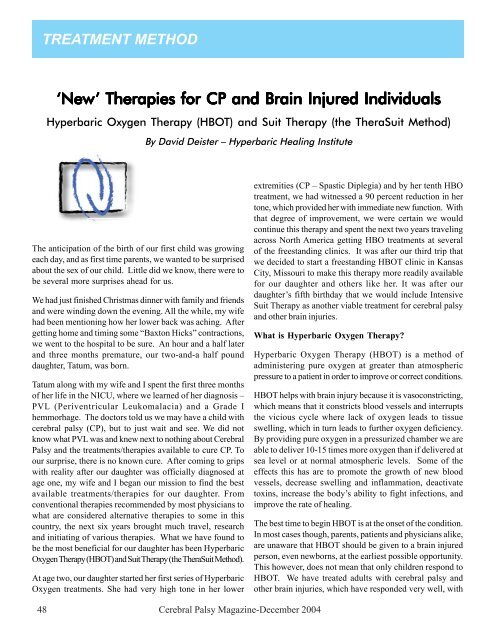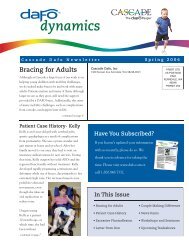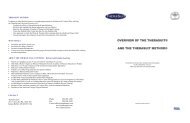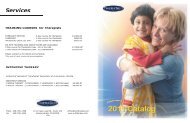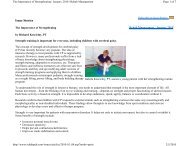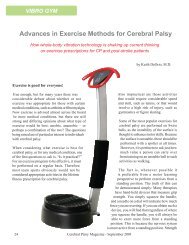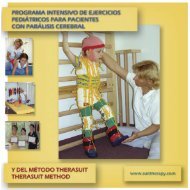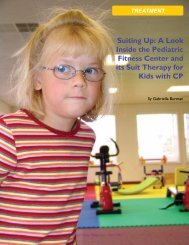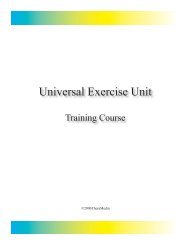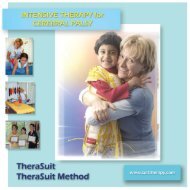Download - TheraSuit Method Intensive Suit Therapy for Cerebral ...
Download - TheraSuit Method Intensive Suit Therapy for Cerebral ...
Download - TheraSuit Method Intensive Suit Therapy for Cerebral ...
You also want an ePaper? Increase the reach of your titles
YUMPU automatically turns print PDFs into web optimized ePapers that Google loves.
TREATMENT METHOD<br />
‘New’ ’ Therapies <strong>for</strong> CP and Brain Injured Individuals<br />
Hyperbaric Oxygen <strong>Therapy</strong> (HBOT) and <strong>Suit</strong> <strong>Therapy</strong> (the <strong>Thera<strong>Suit</strong></strong> <strong>Method</strong>)<br />
By David Deister – Hyperbaric Healing Institute<br />
CME – CUEVAS MEDEK<br />
EXERCISES<br />
The anticipation of the birth of our first child was growing<br />
each day, and as first time parents, we wanted to be surprised<br />
about the sex of our child. Little did we know, there were to<br />
be several more surprises ahead <strong>for</strong> us.<br />
(Formerly known as M.E.D.E.K. <strong>Therapy</strong>)<br />
We had just finished Christmas dinner with family and friends<br />
and were winding down the evening. All the while, my wife<br />
had been mentioning how her lower back was aching. After<br />
getting home and timing some “Baxton Hicks” contractions,<br />
we went to the hospital to be sure. An hour and a half later<br />
and three months premature, our two-and-a half pound<br />
daughter, Tatum, was born.<br />
Tatum along with my wife and I spent the first three months<br />
of her life in the NICU, where we learned of her diagnosis –<br />
PVL (Periventricular Leukomalacia) and a Grade I<br />
hemmorhage. The doctors told us we may have a child with<br />
cerebral palsy (CP), but to just wait and see. We did not<br />
know what PVL was and knew next to nothing about <strong>Cerebral</strong><br />
Palsy and the treatments/therapies available to cure CP. To<br />
our surprise, there is no known cure. After coming to grips<br />
with reality after our daughter was officially diagnosed at<br />
age one, my wife and I began our mission to find the best<br />
available treatments/therapies <strong>for</strong> our daughter. From<br />
conventional therapies recommended by most physicians to<br />
what are considered alternative therapies to some in this<br />
country, the next six years brought much travel, research<br />
and initiating of various therapies. What we have found to<br />
be the most beneficial <strong>for</strong> our daughter has been Hyperbaric<br />
Oxygen <strong>Therapy</strong> (HBOT) and <strong>Suit</strong> <strong>Therapy</strong> (the <strong>Thera<strong>Suit</strong></strong> <strong>Method</strong>).<br />
At age two, our daughter started her first series of Hyperbaric<br />
Oxygen treatments. She had very high tone in her lower<br />
48 <strong>Cerebral</strong> Palsy Magazine-December 2004<br />
extremities (CP – Spastic Diplegia) and by her tenth HBO<br />
treatment, we had witnessed a 90 percent reduction in her<br />
tone, which provided her with immediate new function. With<br />
that degree of improvement, we were certain we would<br />
continue this therapy and spent the next two years traveling<br />
across North America getting HBO treatments at several<br />
of the freestanding clinics. It was after our third trip that<br />
we decided to start a freestanding HBOT clinic in Kansas<br />
City, Missouri to make this therapy more readily available<br />
<strong>for</strong> our daughter and others like her. It was after our<br />
daughter’s fifth birthday that we would include <strong>Intensive</strong><br />
<strong>Suit</strong> <strong>Therapy</strong> as another viable treatment <strong>for</strong> cerebral palsy<br />
and other brain injuries.<br />
What is Hyperbaric Oxygen <strong>Therapy</strong>?<br />
Hyperbaric Oxygen <strong>Therapy</strong> (HBOT) is a method of<br />
administering pure oxygen at greater than atmospheric<br />
pressure to a patient in order to improve or correct conditions.<br />
HBOT helps with brain injury because it is vasoconstricting,<br />
which means that it constricts blood vessels and interrupts<br />
the vicious cycle where lack of oxygen leads to tissue<br />
swelling, which in turn leads to further oxygen deficiency.<br />
By providing pure oxygen in a pressurized chamber we are<br />
able to deliver 10-15 times more oxygen than if delivered at<br />
sea level or at normal atmospheric levels. Some of the<br />
effects this has are to promote the growth of new blood<br />
vessels, decrease swelling and inflammation, deactivate<br />
toxins, increase the body’s ability to fight infections, and<br />
improve the rate of healing.<br />
The best time to begin HBOT is at the onset of the condition.<br />
In most cases though, parents, patients and physicians alike,<br />
are unaware that HBOT should be given to a brain injured<br />
person, even newborns, at the earliest possible opportunity.<br />
This however, does not mean that only children respond to<br />
HBOT. We have treated adults with cerebral palsy and<br />
other brain injuries, which have responded very well, with
HBOT and <strong>Suit</strong> <strong>Therapy</strong><br />
improvements in both physical function and cognitive ability.<br />
So, significant brain recovery is still possible later in life. The<br />
reality that most of us have or will experience is that the<br />
physicians that treat those with cerebral palsy and other brain<br />
injuries have had no exposure to Hyperbaric Medicine during<br />
their careers, so they do not prescribe HBOT.<br />
How can HBOT improve the <strong>Cerebral</strong> Palsy condition<br />
and other brain conditions?<br />
When cells in the brain die, either from trauma or lack of<br />
oxygen, blood plasma leaks out into the surrounding brain<br />
tissue causing swelling and reducing blood flow. These<br />
otherwise normal cells go dormant because they can’t<br />
function without the appropriate amount of oxygen. HBOT<br />
dramatically increases the oxygen carried in the blood<br />
plasma and other bodily fluids (which is normally quite<br />
low) by up to 2,000% making oxygen available to heal<br />
damaged capillary walls, preventing plasma leakage and<br />
reducing swelling. As the swelling decreases, normal blood<br />
flow can be restored to the dormant tissue<br />
(neovascularization) and these cells then have the potential<br />
to go back “on-line” and function normally.<br />
It is at this point, you would expect to see improvement in<br />
the areas where there are deficits. Un<strong>for</strong>tunately, there<br />
are no factors (age, condition, length of time from injury,<br />
etc.) that absolutely predict or guarantee the degree of<br />
improvement. However, what we have experienced at our<br />
facility in treating neurological conditions (infants through<br />
seniors) with HBOT is that 67% received such significant<br />
benefit, that they chose to return <strong>for</strong> additional treatments…<br />
% of Patients who Returned to HHI <strong>for</strong> Additional HBOT<br />
<strong>Cerebral</strong> Palsy 74%<br />
Multiple Sclerosis 71%<br />
PDD / Autism 63%<br />
Stroke 58%<br />
Our findings are similar or greater than some of the more<br />
<strong>for</strong>mal studies done on HBOT and its effect on <strong>Cerebral</strong><br />
Palsy individuals. The following study was presented in<br />
November of 2000.<br />
The Cornell Study (condensed)<br />
Dr Maurine Packard Division of Child Development<br />
and Pediatric Neurology - Study Design<br />
This study was designed as a randomized, delayed entry<br />
trial of the effects of HBOT on children ages 1 to 5 years<br />
with moderate to severe CP. Enrollment criteria were 1)<br />
age between 1 and 5 years; 2) moderate to severe CP; 3)<br />
no evidence of brain mal<strong>for</strong>mation; 4) developmental<br />
delay of at least 33% in one area; 5) no active seizures<br />
<strong>for</strong> the previous 6 months. The protocol consisted of 40<br />
one-hour sessions of HBOT at 1.5 ATA. The sessions were<br />
scheduled twice a day, five days a week <strong>for</strong> four weeks.<br />
We did not design a double blind study, in which some<br />
children would receive placebo treatments, <strong>for</strong> several<br />
reasons. First, this was a pilot study to see if there was<br />
any evidence of benefit <strong>for</strong> these children. Second we<br />
purposefully enrolled children of various ages and<br />
disability levels to evaluate the efficacy of HBOT in a<br />
range of affected children. Third, as time in the chamber<br />
is very expensive, we wanted as much in<strong>for</strong>mation about<br />
treatment effects as possible. Finally, it seemed unethical<br />
to have parents devote so much time and energy to a<br />
potentially ineffective treatment.<br />
Demographics<br />
The study population included 26 children, ages 15<br />
months to 5 years, with cerebral palsy secondary to<br />
prenatal insults, premature birth, birth asphyxia, and<br />
post-natal hemorrhage. The subjects were enrolled at a<br />
rate of 4 per month and matched roughly to age and<br />
severity. The average age at enrollment was 30 months.<br />
The average motor age was 7.5 months; the average<br />
cognitive age and language age were both l2 months.<br />
Nine had cortical visual impairments.<br />
Assessment<br />
Intake assessments included a neuro-developmental<br />
assessment, Bayley II (cognitive assessment), Preschool<br />
Language Scale (language assessment), the Peabody<br />
Motor Scales (an assessment of gross and fine motor<br />
skills), Pediatric Evaluation of Disabilities Inventory<br />
(PEDI), a parental report of specific skill in mobility, selfcare,<br />
and social interactions. Assessments were<br />
conducted at four time points: T1 - at enrollment; T2 -<br />
<strong>Cerebral</strong> Palsy Magazine-December 2004 49
TREATMENT METHOD<br />
after the immediate group received treatment; T3 prior<br />
to the delayed group’s HBOT, 5 months after enrollment;<br />
and T4, after the delayed group’s treatments. Two physical<br />
therapists who were blind to group status administered<br />
the Peabody and the parents completed the PEDI at all<br />
four time points. Child psychologists blinded to group<br />
status per<strong>for</strong>med the Bayley II and PLS at T1 and T3.<br />
Results<br />
Eleven of the 12 children in the immediate group<br />
completed the 40 HBOT sessions. The twelfth child<br />
developed complex febrile seizures and was dropped from<br />
the study. Twelve of 14 delayed children received a full<br />
course of treatment. Two subjects developed seizures and<br />
could not participate. Assessments from each time point<br />
were available on 9 subjects from the immediate treatment<br />
group and from 11 children in the delayed treatment<br />
group.<br />
Parental Diaries<br />
The parents kept weekly diaries during the treatments.<br />
Over the month of treatments, 83% parents noted a<br />
marked improvement in mobility; 43% saw a marked<br />
increase in attention. and 39% reported a marked<br />
increase in language skills. Overall, there was some<br />
improvement with mobility in 21 of 23 children (91%), in<br />
attention in 18 of 23 subjects (78%), in language in 20<br />
out of 23 (87%), and in play in 12 of 23 subjects (52%).<br />
One family saw no improvement and six families saw<br />
minimal improvement, a total of 30%. Five families (22%)<br />
reported major gains in skills and 11 families (48%)<br />
claimed modest gains.<br />
Improvement in vision<br />
Four of the 9 children (44%) with cortical visual<br />
impairment, including two infants with no functional<br />
vision, had improvement in their vision noted by the<br />
families, vision therapists and ophthalmologists.<br />
changes. These children all still have CP, but there are<br />
substantial improvements.<br />
In follow up interviews over 6 months, it was found that<br />
the changes in spasticity were most likely to diminish over<br />
time, but the improvement in attention, language and play<br />
remained. This increase in attention is particularly<br />
important because children must be aware of their<br />
environment in order to learn. This represents a direct<br />
impact on cognitive functioning. The main differences<br />
between HBOT and traditional therapies are the rapid<br />
gains over time and the impact on cognitive skills, which<br />
in general are not improved by PT, OT, and speech<br />
therapies. Whether these changes are the direct result of<br />
increased levels of oxygen or the intensive contact with<br />
the parent or adult in the chamber or other combination<br />
of factors should be the focus of further study.<br />
<strong>Suit</strong> <strong>Therapy</strong> Offered at Hyperbaric Healing Institute<br />
After years of continuing traditional physical therapy <strong>for</strong> our<br />
daughter, we finally had the opportunity to do <strong>Intensive</strong> <strong>Suit</strong><br />
<strong>Therapy</strong> (<strong>Thera<strong>Suit</strong></strong> <strong>Method</strong>) <strong>for</strong> her. After our first<br />
experience with this therapy, we saw substantial<br />
improvements over a two week period in comparison to<br />
months of traditional PT where no noticeable gains were<br />
made.<br />
After subsequent <strong>Suit</strong> <strong>Therapy</strong> sessions and seeing continual<br />
improvements in our daughter, we decided to offer <strong>Suit</strong><br />
<strong>Therapy</strong> at our clinic and opened “Beyond <strong>Therapy</strong>”, a<br />
physical therapy center that offers innovative therapies<br />
including intensive suit therapy. Our mission is to help children<br />
and adults with cerebral palsy and other neuromuscular<br />
disorders achieve greater independence by providing<br />
comprehensive and intensive physical therapy programs.<br />
Conclusion<br />
Our conclusion is that, <strong>for</strong> some children with moderate<br />
to severe CP there is evidence that HBOT improves motor<br />
skills, attention, language, and play. For some, an<br />
increase in vision was noted. These are not miraculous<br />
50 <strong>Cerebral</strong> Palsy Magazine-December 2004
HBOT and <strong>Suit</strong> <strong>Therapy</strong><br />
Our unique approach helps accelerate progress in motor skills.<br />
<strong>Intensive</strong> therapy can provide strengthening, flexibility,<br />
increased endurance and enhanced functional skills. Many<br />
patients acquire skills such as rolling, crawling, sitting, and/<br />
or walking, which they have never been able to do prior<br />
to participating in this type of physical therapy program.<br />
At Beyond <strong>Therapy</strong>, we utilize many tools including<br />
the <strong>Thera<strong>Suit</strong></strong> which is a modification of the Space <strong>Suit</strong><br />
originally designed by the Soviet Space Program. The<br />
<strong>Suit</strong> is comprised of a cap, vest, shorts, kneepads, and<br />
specially adapted shoes that are connected to each other<br />
through a system of adjustable straps and elastic bands.<br />
It aligns the body, normalizes muscle tone, improves<br />
proprioception and reduces pathological reflexes.<br />
From the onset, our only patients to utilize both HBOT<br />
and <strong>Suit</strong> <strong>Therapy</strong> were children. This group responded<br />
well to both treatment methods and continued with<br />
additional treatment. It wasn’t until recently that we<br />
treated our first adult with <strong>Cerebral</strong> Palsy, utilizing both<br />
HBOT and <strong>Intensive</strong> <strong>Suit</strong> <strong>Therapy</strong>. The following<br />
in<strong>for</strong>mation is provided by the physical therapists who<br />
worked with this patient, using <strong>Suit</strong> <strong>Therapy</strong> (<strong>Thera<strong>Suit</strong></strong><br />
<strong>Method</strong>).<br />
Adult with <strong>Cerebral</strong> Palsy Utilizing <strong>Suit</strong> <strong>Therapy</strong><br />
Range of Motion:<br />
Lower Extremity (passive ROM) LEFT RIGHT<br />
(Eval) (Discharge) (Eval) (Discharge)<br />
Hip Abduction 20° No ∆* 20° No ∆<br />
Hip Adduction WFL No ∆ WFL No ∆<br />
Hip Flexion 115° 110° (-5°) 115° 112° (-3°)<br />
Hip Extension 0° No ∆ 0° No ∆<br />
Hip Internal Rotation 45° 50° (+5°) 30° 50° (+20°)<br />
Hip External Rotation 35° 45° (+10°) 40° 55° (+15°)<br />
Knee Extension (hamstrings) Lacks 45° Lacks 30° (+15°) Lacks 50° Lacks 40° (+10°)<br />
Knee Flexion WFL No ∆ WFL No ∆<br />
Ankle Plantarflexion WNL No ∆ WNL No ∆<br />
Ankle Dorsiflexion (knee extended) 10° No ∆ No ∆ No ∆<br />
*No ∆ - No Change<br />
<strong>Cerebral</strong> Palsy Magazine-December 2004 51
TREATMENT METHOD<br />
These changes were noted over a four week period of time. The patient is 26 years old.<br />
Postural Improvements:<br />
Be<strong>for</strong>e - September 13, 2004<br />
Anterior pelvic tilt with excessive lordosis<br />
Hips and knees flexed<br />
Forward, protracted shoulders<br />
Forward head posture<br />
After - October 15, 2004<br />
Neutral pelvis with decreased lordosis<br />
Improved hip extension<br />
Improved shoulder retraction<br />
Head retraction with chin tuck<br />
Strength: 40% - 64% increase in weight resistance<br />
from initial visit to discharge.<br />
Endurance: Increased endurance from two minutes<br />
of aerobic activity to seven minutes be<strong>for</strong>e fatiguing.<br />
Gait: Initially, the client was unable to independently<br />
correct posture (statically or during gait). Upon<br />
discharge, the client was able to independently<br />
correct posture and maintain <strong>for</strong> 10 feet be<strong>for</strong>e needing<br />
to be cued <strong>for</strong> re-correction.<br />
Note: Client demonstrates leg length discrepancy of 2<br />
cm. with pelvic obliquity. A shoe lift was recommended<br />
upon discharge. Postural improvements were more<br />
pronounced with correction <strong>for</strong> leg length. In these<br />
pictures, leg length discrepancy is uncorrected.<br />
Closing Remarks<br />
52 <strong>Cerebral</strong> Palsy Magazine-December 2004<br />
Hyperbaric Oxygen <strong>Therapy</strong> is not the miracle cure <strong>for</strong><br />
those with cerebral palsy and other neurological conditions,<br />
but it is a simple treatment that is part of the solution to the<br />
most comprehensive recovery possible. HBOT combined<br />
with <strong>Suit</strong> <strong>Therapy</strong> (intensive physical therapy) is encouraged<br />
because of the benefit from muscle activation. Even though<br />
patients may have significant improvements from HBOT,<br />
<strong>Suit</strong> <strong>Therapy</strong> provides many additional benefits needed<br />
by these individuals, such as assisting to reverse changes<br />
caused by lack of use in muscles and joints.<br />
We have had much success in treating the people at our<br />
clinic, but none of what has been achieved would be possible<br />
if not <strong>for</strong> some very talented, dedicated and caring physical<br />
therapists, respiratory therapists and nurses.<br />
If you would like additional in<strong>for</strong>mation on Hyperbaric<br />
Oxygen <strong>Therapy</strong> and <strong>Suit</strong> <strong>Therapy</strong>, please contact:<br />
Hyperbaric Healing Institute David and Lisa Deister<br />
Phone: (866) 801-7878<br />
Web site: www.HHI-KC.com<br />
E-mail: info@HHI-KC.com


